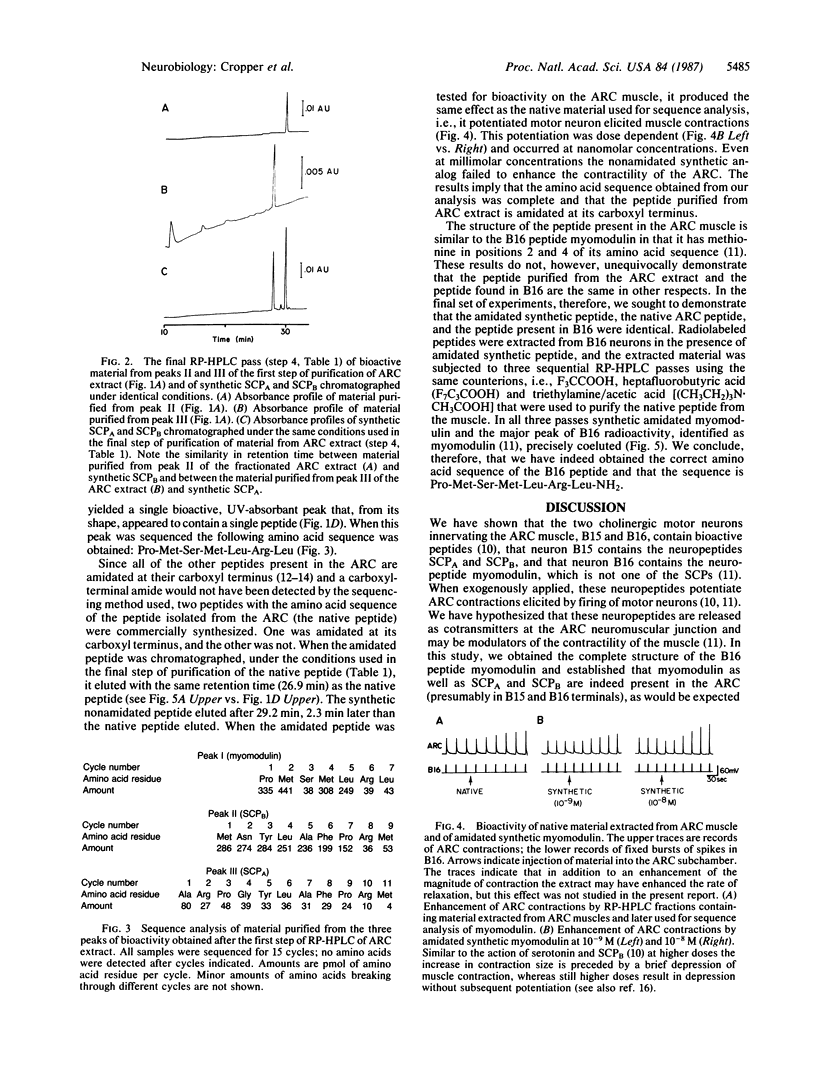Abstract
When Aplysia are initially exposed to food stimuli, their biting responses show progressive increases in speed and strength. The accessory radula closer (ARC) buccal muscles have been used to study this phenomenon, and it has been shown that changes in ARC muscle contraction are partially due to activity of a serotonergic neuron that modulates this muscle, by both a direct action and an action on two ARC motor neurons (B15 and B16). The motor neurons use acetylcholine as their excitatory transmitter, but they also contain bioactive peptides that can potentiate muscle contractions when they are exogenously applied. Motor neuron B15 contains the structurally related small cardioactive peptides A and B, whereas motor neuron B16 contains a different peptide--termed myomodulin. In the present study we determined the full amino acid sequence of myomodulin. Myomodulin is present in the ARC muscle, and exogenous application of the peptide potentiates ARC muscle contractions in a manner similar to the potentiation by small cardioactive peptides A and B. The structure of myomodulin, however, bears little resemblance to the small cardioactive peptides. Thus it appears that ARC muscle contractions may be regulated by at least three distinct classes of neuromodulators: serotonin, the small cardioactive peptides, and myomodulin.
Full text
PDF



Selected References
These references are in PubMed. This may not be the complete list of references from this article.
- Cohen J. L., Weiss K. R., Kupfermann I. Motor control of buccal muscles in Aplysia. J Neurophysiol. 1978 Jan;41(1):157–180. doi: 10.1152/jn.1978.41.1.157. [DOI] [PubMed] [Google Scholar]
- Cropper E. C., Lloyd P. E., Reed W., Tenenbaum R., Kupfermann I., Weiss K. R. Multiple neuropeptides in cholinergic motor neurons of Aplysia: evidence for modulation intrinsic to the motor circuit. Proc Natl Acad Sci U S A. 1987 May;84(10):3486–3490. doi: 10.1073/pnas.84.10.3486. [DOI] [PMC free article] [PubMed] [Google Scholar]
- Fontaine B., Klarsfeld A., Hökfelt T., Changeux J. P. Calcitonin gene-related peptide, a peptide present in spinal cord motoneurons, increases the number of acetylcholine receptors in primary cultures of chick embryo myotubes. Neurosci Lett. 1986 Oct 30;71(1):59–65. doi: 10.1016/0304-3940(86)90257-0. [DOI] [PubMed] [Google Scholar]
- Gibson S. J., Polak J. M., Bloom S. R., Sabate I. M., Mulderry P. M., Ghatei M. A., McGregor G. P., Morrison J. F., Kelly J. S., Evans R. M. Calcitonin gene-related peptide immunoreactivity in the spinal cord of man and of eight other species. J Neurosci. 1984 Dec;4(12):3101–3111. doi: 10.1523/JNEUROSCI.04-12-03101.1984. [DOI] [PMC free article] [PubMed] [Google Scholar]
- Kupfermann I. Feeding behavior in Aplysia: a simple system for the study of motivation. Behav Biol. 1974 Jan;10(1):1–26. doi: 10.1016/s0091-6773(74)91644-7. [DOI] [PubMed] [Google Scholar]
- Lloyd P. E., Kupfermann I., Weiss K. R. Evidence for parallel actions of a molluscan neuropeptide and serotonin in mediating arousal in Aplysia. Proc Natl Acad Sci U S A. 1984 May;81(9):2934–2937. doi: 10.1073/pnas.81.9.2934. [DOI] [PMC free article] [PubMed] [Google Scholar]
- Lloyd P. E., Kupfermann I., Weiss K. R. Sequence of small cardioactive peptide A: a second member of a class of neuropeptides in Aplysia. Peptides. 1987 Jan-Feb;8(1):179–184. doi: 10.1016/0196-9781(87)90184-7. [DOI] [PubMed] [Google Scholar]
- Mahon A. C., Lloyd P. E., Weiss K. R., Kupfermann I., Scheller R. H. The small cardioactive peptides A and B of Aplysia are derived from a common precursor molecule. Proc Natl Acad Sci U S A. 1985 Jun;82(11):3925–3929. doi: 10.1073/pnas.82.11.3925. [DOI] [PMC free article] [PubMed] [Google Scholar]
- Morris H. R., Panico M., Karplus A., Lloyd P. E., Riniker B. Elucidation by FAB-MS of the structure of a new cardioactive peptide from Aplysia. Nature. 1982 Dec 16;300(5893):643–645. doi: 10.1038/300643a0. [DOI] [PubMed] [Google Scholar]
- O'Shea M., Schaffer M. Neuropeptide function: the invertebrate contribution. Annu Rev Neurosci. 1985;8:171–198. doi: 10.1146/annurev.ne.08.030185.001131. [DOI] [PubMed] [Google Scholar]
- Ono J. K., McCaman R. E. Identification of additional histaminergic neurons in Aplysia: improvement of single cell isolation techniques for in tandem physiological and chemical studies. Neuroscience. 1980;5(5):835–840. doi: 10.1016/0306-4522(80)90152-9. [DOI] [PubMed] [Google Scholar]
- Price D. A., Greenberg M. J. Structure of a molluscan cardioexcitatory neuropeptide. Science. 1977 Aug 12;197(4304):670–671. doi: 10.1126/science.877582. [DOI] [PubMed] [Google Scholar]
- Richmond J. E., Bulloch A. G., Lukowiak K. Peptidergic modulation of a neuromuscular junction in Aplysia: bioactivity and immunocytochemistry. Brain Res. 1986 Apr 2;370(1):159–164. doi: 10.1016/0006-8993(86)91117-0. [DOI] [PubMed] [Google Scholar]
- Rosen S. C., Kupfermann I., Goldstein R. S., Weiss K. R. Lesion of a serotonergic modulatory neuron in Aplysia produces a specific defect in feeding behavior. Brain Res. 1983 Jan 31;260(1):151–155. doi: 10.1016/0006-8993(83)90778-3. [DOI] [PubMed] [Google Scholar]
- Weiss K. R., Cohen J. L., Kupfermann I. Modulatory control of buccal musculature by a serotonergic neuron (metacerebral cell) in Aplysia. J Neurophysiol. 1978 Jan;41(1):181–203. doi: 10.1152/jn.1978.41.1.181. [DOI] [PubMed] [Google Scholar]
- Weiss K. R., Mandelbaum D. E., Schonberg M., Kupfermann I. Modulation of buccal muscle contractility by serotonergic metacerebral cells in Aplysia: evidence for a role of cyclic adenosine monophosphate. J Neurophysiol. 1979 May;42(3):791–803. doi: 10.1152/jn.1979.42.3.791. [DOI] [PubMed] [Google Scholar]


